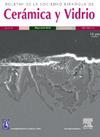Praseodymium and gadolinium doped ceria as oxygen electrode for solid oxide cell applications
IF 2.7
4区 材料科学
Q1 MATERIALS SCIENCE, CERAMICS
Boletin de la Sociedad Espanola de Ceramica y Vidrio
Pub Date : 2025-03-01
DOI:10.1016/j.bsecv.2025.03.003
引用次数: 0
Abstract
This study analyzes the structural and electrochemical properties of praseodymium- and gadolinium-doped ceria (CPGO) samples formed by the sintering reaction of Pr2NiO4+δ (PNO) and Ce0.9Gd0.1O2−δ (GDC). X-ray powder diffraction analysis confirmed a single-phase cubic CPGO structure as a primary phase. The cationic compositions were determined using energy dispersive spectroscopy (EDS) in a scanning transmission electron microscope (STEM), while core-loss electron energy-loss spectroscopy (EELS) was used to determine the valence of Ce and Pr. The compatibility between thermal expansion coefficients validated their integration with electrolytes at the typical Solid Oxide Cell (SOC) operation temperatures. Oxygen chemical diffusion and surface exchange coefficients were investigated using the electrical conductivity relaxation (ECR) method at intervals of partial oxygen pressures between 0.10 and 0.21 atm and 600 °C and 800 °C. Finally, the samples were tested in symmetrical cells by electrochemical impedance spectroscopy (EIS) between 700 °C and 850 °C. A polarization resistance of 0.17 Ω cm2 at 850 °C was obtained for CPGO air electrodes formed by sintering a mixture of 80% by weight of GDC and 20% by weight of PNO. These findings confirm that PNO–GDC mixtures forming CPGO oxides are excellent candidates for SOC applications.

掺杂镨和钆的铈作为固态氧化物电池应用的氧电极
本研究分析了Pr2NiO4+δ (PNO)与Ce0.9Gd0.1O2−δ (GDC)烧结反应生成的掺镨和掺钆铈(CPGO)样品的结构和电化学性能。x -射线粉末衍射分析证实其为单相立方CPGO结构。利用扫描透射电子显微镜(STEM)的能谱分析(EDS)确定了阳离子组成,并利用核心损失电子能谱分析(EELS)确定了Ce和Pr的价态。热膨胀系数之间的相容性验证了它们在典型固体氧化物电池(SOC)工作温度下与电解质的整合。采用电导率弛豫(ECR)方法研究了在分氧压力为0.10 ~ 0.21 atm、600 ~ 800℃区间内的氧化学扩散系数和表面交换系数。最后,用电化学阻抗谱(EIS)在700 ~ 850℃的温度下在对称电池中进行测试。在850℃下,由80% GDC和20% PNO混合烧结而成的CPGO空气电极的极化电阻为0.17 Ω cm2。这些发现证实,形成CPGO氧化物的PNO-GDC混合物是SOC应用的优秀候选者。
本文章由计算机程序翻译,如有差异,请以英文原文为准。
求助全文
约1分钟内获得全文
求助全文
来源期刊

Boletin de la Sociedad Espanola de Ceramica y Vidrio
工程技术-材料科学:硅酸盐
CiteScore
5.50
自引率
2.90%
发文量
72
审稿时长
103 days
期刊介绍:
The Journal of the Spanish Ceramic and Glass Society publishes scientific articles and communications describing original research and reviews relating to ceramic materials and glasses. The main interests are on novel generic science and technology establishing the relationships between synthesis, processing microstructure and properties of materials. Papers may deal with ceramics and glasses included in any of the conventional categories: structural, functional, traditional, composites and cultural heritage. The main objective of the Journal of the Spanish Ceramic and Glass Society is to sustain a high standard research quality by means of appropriate reviewing procedures.
 求助内容:
求助内容: 应助结果提醒方式:
应助结果提醒方式:


